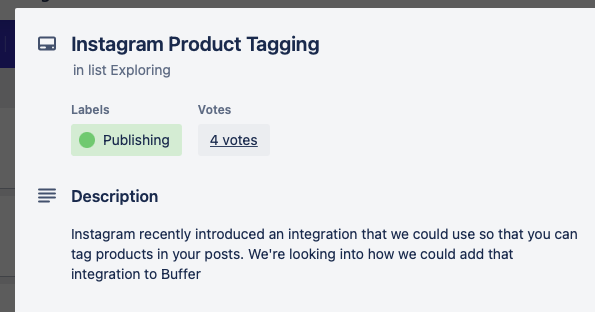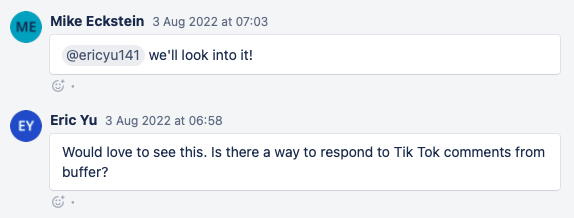How to Build a Trello Roadmap: Your Product Roadmap

Ruben Buijs
Updated on Mar 13, 2024
Making a roadmap in Trello is a powerful way to plan your product's journey. With a roadmap, you can organize goals and visualize the path to achieve them. Let's learn how to create your Trello roadmap in a simple yet effective way.
Table of contents
- Step-by-step: Create roadmaps with Trello
- Tips to create your Trello Product Roadmaps
- Trello vs Purpose-built public roadmap
- What is a public product roadmap?
- What is Trello?
- Why do you need a Trello roadmap?
- Trello roadmapping vs project plan
- FAQ
- Conclusion
Step-by-step: Create roadmaps with Trello
Here are the steps for building a SaaS product roadmap in Trello.
This is an example of what we are making:
1. Create a new board in Trello
This Trello board will be the main container for your product roadmap.
You can name the Trello board something like "Product Roadmap" or "[Product Name] Roadmap."
2. Create lists to represent different time periods or stages in the roadmap
You can create lists to represent different periods or stages in the roadmap, such as "Next Quarter," "Q2," "Q3," etc.
Alternatively, you can create lists to represent different stages in the product development process, such as "Ideas," "In Progress," "Completed," etc.
These will be your columns in the Trello board.
3. Create cards to represent features or milestones
For each feature or milestone in your roadmap, create a card in Trello and assign it to the appropriate list.Start by creating a new card for each item on your roadmap.
These cards can represent user stories, feature requests, or key objectives.
You can integrate these cards into your broader product development process, prioritizing as you go.
For each feature or milestone in your roadmap, create a card and assign it to the appropriate list.
You can add details to the Trelo cards, such as a description, attachments, labels, and due dates.
4. Share the Trello board with your team and users
Once you have created your public product roadmap in Trello, you can invite your customers, team members, and other stakeholders to the board to collaborate on the roadmap and provide feedback.
Make sure your roadmap is on Public before you are sharing the link.
By following these steps, you can build a product roadmap that is easy to understand and collaborate on and helps keep your team aligned around the product vision and strategy.
Trello provides a starter template that you can use to make a roadmap.
Tips to create your Trello Product Roadmaps
Use labels to categorize cards
In Trello, you can use labels to categorize cards by type, priority, or any other relevant criteria, making it easier to filter and group the cards on the board.You can use labels to categorize cards by type, priority, or any other relevant criteria, making it easier to filter and group the cards on the board.
Use color tags to customize your layout, offering a clear, readable overview of near-term, medium-term, and far-term goals.
This helps in roadmapping your product's journey.
Add attachments and checklists
You can add attachments to the Trello cards, such as mockups or design documents, to provide more context and detail.
Using checklists can also break down larger tasks into smaller, actionable items.
Asking for feedback
There are two options to ask for feedback in Trello:
-
Use the @mention feature: You can use Trello's @mention feature to notify specific team members or stakeholders when you want to get their feedback on a card.
Type "@" followed by the name of the person you want to mention, and Trello will notify them.
-
Use the comment feature: You can use the comment feature to leave a message or ask a question on a card.
Click the "Add Comment" button on the bottom of the Trello card, and type your message.
You can enable comments on your roadmap items, letting customers submit their own ideas. It’s a transparent way to gather customer feedback and increase your chances for success.
You can also ask users to vote for for cards. This way you can keep track of feedback from users and let people know when things are ready when released (manually though).
Use checklists
Each card can be seen as a separate initiative with its own checklist, providing a bird’s eye view of what's happening.
You can integrate 3rd party power-ups like Planyway to create timelines, adding transparency to your process.
Add images or icons
You can add images and icons to make your Trello public roadmap look more cool.
Feature requests
Encourage users to submit their ideas by creating a card for each idea and adding it to a "New Ideas" list.
You can also create a template card that users can copy and fill out with their ideas.
If you don't want additional clutter on your Trello board, you can ask users to fill in a form.
But note, that you need someone to go through all the ideas.
If that becomes a lot, it would be better to use a feedback management board.
Trello vs Purpose-built public roadmap
Trello is a more general project management tool that can also be used for roadmaps.
More purpose-built solutions like ProductLift offer several benefits over Trello for creating a product roadmap, such as more advanced customization options, visual roadmapping, and linking roadmaps to specific releases and versions.
ProductLift also provides a dedicated space for high-level planning and strategy, which can help keep your product roadmap focused and aligned with your overall business goals.
Additionally, ProductLift's prioritization matrix makes creating and updating your product roadmap used on customer data easy, saving you time and effort in the long run.
While Trello can be a valuable tool for managing projects, it may offer limited functionality and customization than ProductLift for creating and maintaining a product roadmap.
Ultimately, the choice between ProductLift and Trello depends on your product development team's specific needs and priorities.
What is a public product roadmap?
A product roadmap is a high-level visual summary that maps out the vision and direction of a product.
It outlines the planned features, objectives, and milestones for a product over a specific period of time, typically 6-18 months.
A product roadmap aims to align the team around the product vision and strategy and to communicate that vision and strategy to stakeholders such as customers, investors, and executives.
A product roadmap is not a detailed project plan but a high-level overview that can evolve as the product and market grow.
This guide will explain how you create your Trello product roadmap.
You can also go for a more professional approach using a dedicated roadmap tool such as ProductLift.
What is Trello?
Trello is a project management and collaboration tool that allows you to organize and prioritize your work and projects.
It is based on the concept of a "kanban" board, a system for visualizing and organizing work.
This sounds familiar if you are into Agile because the Scrum Board is a Kanban Board.
Trello boards
In Trello, you create "boards" for different projects and create "cards" to represent tasks or ideas.
You can then organize these cards into "lists" and assign them to team members or add labels to them to categorize them.
This is also how we will make your Trello product roadmap.
Trello is highly customizable and can be used for various purposes, including SaaS product management, event planning, and team collaboration.
Why do you need a Trello roadmap?
A product roadmap provides a clear overview of the product and helps to align the team around the product objectives and strategy.
A product roadmap can also help to identify dependencies, potential risks, and key decision points. It is a valuable tool for communicating the product plan to stakeholders, such as executives, customers, and investors and gaining their buy-in and support.
A SaaS roadmap can also help track progress and identify any deviations from the plan. A roadmap can help ensure the product stays on track and delivers the intended business value.
Trello roadmapping vs project plan
A roadmap is a high-level overview of the planned direction and progress of a product or project, while a project plan is a detailed document that outlines the specific steps and resources needed to complete a project.
A roadmap typically covers a longer time horizon, usually 6-18 months, and is focused on the major milestones and deliverables. It is a high-level visual summary that helps align the team around the product or project vision and strategy and communicates that vision and strategy to stakeholders.
On the other hand, a project plan is a more detailed document that outlines the specific tasks, resources, and timeline for completing a project. It typically covers a shorter period, such as a few months or less, and includes a detailed breakdown of the work required to complete the project. A project plan is used to manage and track the project's progress and to identify any deviations from the plan.
In summary, a roadmap is a high-level overview of a product or project's planned direction and progress. In contrast, a project plan is a detailed document that outlines the specific steps and resources needed to complete a project.
FAQ
Does Trello have a roadmap feature?
Yes, Trello does have a roadmap feature. This can be created by using Trello boards and lists, with cards representing individual tasks. You can use labels and due dates to provide more detail about each task.
How do I use Trello for a roadmap?
To use Trello for a roadmap, you first need to create a new board. Then, create lists that represent stages of your project or timeframes. Add cards to these lists to represent tasks or milestones. You can assign these cards to team members, add due dates, and use labels to categorize tasks.
What is the difference between Trello and Jira?
Trello and Jira are both project management tools, but they cater to different needs and workflows. Trello is best for simple, visual planning and is great for small teams or projects. On the other hand, Jira offers more robust features that are well-suited to large-scale, complex projects with many team members. It is especially popular in software development due to its strong support for agile workflows.
Does Trello have a timeline?
While Trello doesn't have a built-in timeline feature, it can be integrated with other tools like ProductLift to create a visual timeline or Gantt chart of your Trello boards.
What companies use Trello?
Buffer, Attendify, and Monzo are using Trello for their roadmaps.
Companies like Monzo, a bank service based in the UK, use a Trello roadmap to provide extra information to stakeholders and send messages directly to the team.
They've found it's the best option for maintaining a clear, visual representation of their development process.
Conclusion
In the end, creating a Trello product roadmap can seem like a big task, but the clear overview it offers makes it worth the effort.
Don't be afraid to get inspired and experiment with different templates or layouts.
Remember, the goal of your Trello roadmap is to help your team and stakeholders understand where you're going and how you'll get there. Happy roadmapping!










